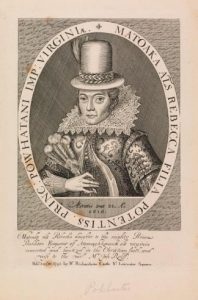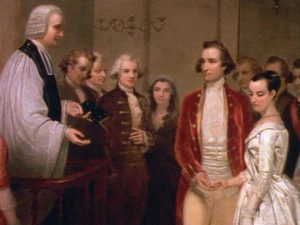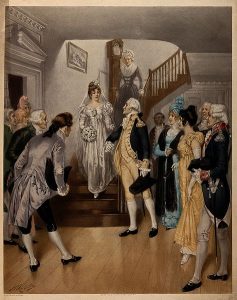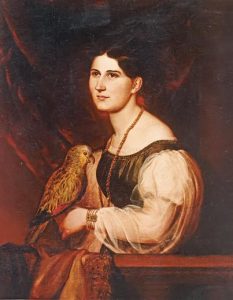By Barbara Crookshanks
These five brides from three centuries left distinctive imprints on Virginia history. One was a humble serving girl; another was an Indian princess. The other brides were a mother, granddaughter, and great-granddaughter whose marriages would place them at the forefront of national affairs.
For each, their weddings were times of celebration. The future would take them along unexpected and divergent paths.
Anne Burroughs
Jamestown — Autumn, 1608
Anne Burroughs,* believed to be the first English bride in North America, arrived in Jamestown as "maide to Mistress Forrest." in October of 1608. They were said to be the first women of record in Jamestown.
Anne, who was about 18 years old, married John Laydon six weeks after her arrival in the colony. The Reverend Robert Hunt performed the ceremony which was recorded by Captain John Smith.
As a bride of one year, Anne experienced the "starving time" during the winter of l609-10. She and her husband were among those who survived. The couple also escaped the Good Friday massacre of 1622 when approximately 347 Virginia settlers were killed or taken prisoner.
The last known record of Anne and John Laydon dates to 1625. She was 30 and he was 44. They were living in the Elizabeth City area, now Hampton, with their four daughters, Virginia, Katherine, Alice, and Margerett.
Pocahontas
Jamestown — April 1614
The Powhatan Princess Pocahontas, "dearest" daughter of Chief Powhatan, was married to John Rolfe in the church at Jamestown in April of 1614.
The legend of how "Little Mischief," as she was called, saved Captain John Smith from his Indian executioners in 1608 has been handed down from generation to generation. In 1612 or 13 when Pocahontas was about 17, she visited the Algonquian village named Patawomeck, north of Accokeek Creek in Stafford County. She was captured by Samuel Argall, captain of the Treasurer, and held as hostage for English prisoners, food supplies, and weapons.
In Jamestown, Pocahontas was baptized in the Christian religion and took the name Rebecca. She fell in love with Englishman John Rolfe, and they were wed in 1614. Following their marriage—which was blessed by her father, the colonists and Indians enjoyed a time of tranquil relations which were called "the Peace of Pocahontas." In 1616, Rebecca and John sailed for England where she was called the "Non-Pareil of Virginia." The Bishop of London entertained her "with festivall, state and pompe."
Samuel Purchas wrote that she "did not only accustome her selfe to civilitie, but still carried herselfe as the daughter of a King."
Her young life ended abruptly. Preparing to return to America with her husband and young child, Thomas, she fell mortally ill. She was buried at the Church of St. George at Gravesend in Kent where a life-size statue honors her.
Martha Dandridge Custis
White House Plantation — January 5, 1759
It was Twelfth Night (Old Christmas), January 5, 1759, at Martha Dandridge Custis' White House Plantation** on the Pamunkey River. Here she would wed George Washington.
Their wedding day was also the climax of the long Christmas holidays, and the elegant rooms were filled with well-wishers. They dined on ham, oysters, enormous roasts of beef and pork, jams, jellies, spirited punches and toddies, quavery desserts, cakes and pies filled with fruit and cream.
Martha literally had to look up to her bridegroom for she was only about five feet tall. Her contemporaries described her as "dark-haired, gentle of manner" and "fair to behold, of fascinating manners."
She also was one of the richest women in Virginia. The widow of the wealthy Daniel Parke Custis, she brought to her new husband a little iron chest*** filled with 30,000 pounds sterling in certificates of deposit on the Bank of England.
More importantly, she brought George her cheerful love and understanding as she followed him to the battlefields of the American Revolution and then became the first First Lady of the United States.
Her favorite role was that of quiet domesticity as the mistress of Mount Vernon. To George, Martha was his "dear Patsy"; he wore a miniature of her in a locket around his neck.
Eleanor Parke "Nelly" Custis
Mount Vernon — February 22, 1799
Nelly Custis, a brown-eyed brunette called "one of the most beautiful women of her day," came down the staircase to be wed at Mount Vernon. Her magnificent white plumes were a gift from her adopted father, George Washington.
Her wedding took place on the evening of February 22, 1799. It was the last birthday of the first President of the United States, who gave her in marriage.
Her bridegroom was Lawrence Lewis, son of George's sister, Betty Washington Lewis of Kenmore. He was Washington's secretary and host at Mount Vernon. Nelly wrote that she had been "surprised by cupid."
The couple's wedding trip — a series of visits to relatives and to the springs — lasted until fall. Then they settled down at Mount Vernon, and George and Martha were delighted. They had raised Nelly from babyhood and loved her dearly as they satisfied her every whim.
However, happy as he was to have Nelly home again, George was concerned about what he called Lawrence's "apparent indolence." Washington had given Nelly 2,000 acres from Mount Vernon and was anxious that Lawrence start farming it.
Nelly and Lawrence lived at Mount Vernon until Martha Washington's death in 1802. They then established Woodlawn Plantation on the land George had given Nelly. For a while, they were happy parents, and Nelly became a capable housekeeper.
But as the decades passed, their incompatible temperaments became more pronounced. Nelly was lively and fun-loving; Lawrence was grave, serious and retiring. Although they stayed together, friends said they seemed happier apart.
At Mount Vernon, they are close, yet apart. In death, Lawrence is buried in the Washington vault; close by is Nelly's granite obelisk with this inscription: "This lady was not more remarkable for the beauty of her person than the superiority of her mind..."
Mary Anna Randolph Custis
Arlington House — June 30, 1831
Candles blazed in the rooms of majestic Arlington House on the evening of June 30, 1831. All was in readiness for the wedding of Mary Anna Randolph Custis and Lieutenant Robert E. Lee.
The heiress bride was the only daughter of George Washington Parke Custis. Her great-grandmother was Martha Washington. The groom, though poor in worldly goods, had an equally impressive pedigree: he was the son of Revolutionary War hero "Light Horse" Harry Lee and was a descendant of the Lees of Stratford Hall. Mary and Robert had known each other since childhood.
Although all was joyful festivity inside Arlington House, outside the weather was not cooperating. Marietta Turner, a bridesmaid, described the scene: "Mid-summer rain denied the company the enjoyment of the gardens which commanded an unparalleled view of the Potomac and the city of Washington.
"Much fun arose from the appearance of the Rev. Mr. Ruel Keith, who arrived drenched to the skin and though a tall man was compelled to conduct the nuptial service in the clothes of my cousin George Washington Parke Custis, a very great gentleman, but a very small man, so far as inches are concerned.
"My cousin [Mary Custis], always a modest and affectionate girl, was never lovelier, and Robert Lee, with his bright eyes and high color, was the picture of a cavalier. The elegance and simplicity of the bride's parents presiding over the feast and the happiness of the servants remain in my memory as a piece of Virginia life pleasant to recall."
The wedding party, including the bride and groom, remained at Arlington for a week of merriment and festivities. Lieutenant and Mrs. Lee then began a round of visits to their relatives. In August, they departed for Robert's duty station with the Corps of Engineers at Fort Monroe where their first home consisted of a single room.
Additional Resources:
George Washington's Beautiful Nelly
*also spelled as Burras and Burrows
**The White House was located on the Pamunkey River in the Hanover Court House area. The original White House was destroyed by fire about 30 years before the Civil War. The second plantation house, the property of General Lee's son Confederate cavalry officer William Henry Fitzhugh "Rooney" Lee, became a Union base during the war.
***Martha Washington's little iron chest measured 20 inches in length, 13 inches in width and 11 inches in depth, heavily banded and secured by two bolt locks and two padlocks. The chest's measurements and description were carefully recorded in picture and words by author-illustrator Benson J. Lossing. Preparing an article for the September 1853 issue of Harper's New Monthly Magazine, he discovered the chest at Arlington House, the seat of George Washington Parke Custis, grandson of Martha and the adopted son of George Washington.”





